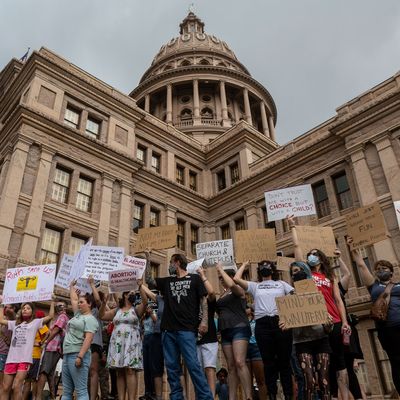
It’s been five months since Texas effectively banned all abortions past six weeks, and so far the law appears to be doing exactly what its proponents hoped: slashing the number of procedures performed in the state. New data from the Texas Health and Human Services Commission shows a 60 percent drop in abortions during S.B. 8’s first 30 days of enactment alone.
But while the numbers are down in Texas, they’re up in neighboring states straining to accommodate the overflow. So while that statistic is alarming, it doesn’t present a full picture.
But first, Texas: Starting September 1, the state outlawed abortion at the first glimmer of fetal “cardiac activity” even when a pregnancy results from rape or incest. That deadline comes well before many people know they’re pregnant; it also violates the terms of Roe v. Wade, which prohibits states from restricting abortion before viability (around 23 weeks). Texas maneuvered around this obstacle by offering at least a $10,000 reward to vigilantes — inside and outside the state — willing to sue anyone they suspect of “aiding and abetting” abortion, removing local government from the equation while posing a formidable financial barrier to clinics often operating on tight margins. As the case wound its way through the court system all the way to the Supreme Court (which has repeatedly declined to block the law), many providers suspended abortion services.
Early on, clinics reported panic and confusion among would-be patients, many of whom would now have to cross state lines if they wanted to terminate their pregnancies.
Against that backdrop, it probably isn’t surprising that state officials recorded 2,200 abortions in September versus 5,400 in August. In October, researchers at the University of Texas at Austin were already projecting a 50 percent drop for September 2021 compared with September 2020. And before the law took effect, Planned Parenthood Gulf Coast predicted the law would stop between 85 and 90 percent of abortions in Texas. S.B. 8’s impact is devastating, and yet the state’s statistics don’t account for all the patients who have been driven into neighboring states and well beyond.
According to the Texas Tribune, Planned Parenthood centers in surrounding states saw a 1,082 percent increase in Texas residents in September compared with the two previous years. In the weeks that followed S.B. 8’s enactment, Planned Parenthood reps in New Mexico told Insider they’d seen a 67 percent rise in Texas patients, while in Oklahoma, that number shot up to 133 percent. The Guttmacher Institute reported that some Texans traveled even farther than Oklahoma, Louisiana, New Mexico, and Arkansas, where clinics have fallen short of surging demand even with extended hours. Some Texans went as far as Washington State in order to terminate their pregnancies.
So while lawmakers have taken huge steps toward their ultimate goal of preventing people from getting abortions in Texas, they have not necessarily prevented them from getting abortions full stop.
It’s worth noting who gets left behind in this scenario. It’s not people who can afford to get on an airplane or take multiple days off work to make a morning-to-night drive and satisfy 24-to-72-hour waiting-period demands. The most common abortion patient is young, poor, and may have at least one other kid at home. Setting aside the cost of the procedure (Guttmacher places it around $500 on average at 10 weeks, though that price tag balloons the longer a person waits), there are factors like child care, gas, housing, and lost wages to consider. When Texas governor Greg Abbott temporarily banned abortions during the early days of the coronavirus pandemic, “the folks that went out of state and came back to have follow-up care tended to be higher-income, tended to be white folks,” Houston Planned Parenthood doctor Bhavik Kumar told the Tribune. The many people left to just wait it out, who in some cases came right up against the state’s 20-week deadline, “were the folks that were low-income, folks of color, especially Black women.” And it is always that patient whom these lawmakers want you to forget.





